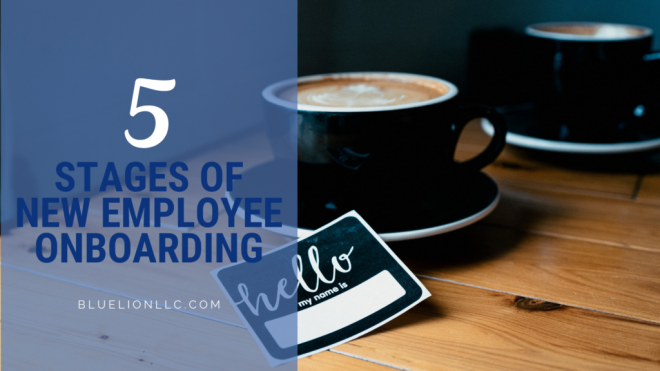
Did you know that effective new employee onboarding can increase retention by 25% and improve employee performance by 11%?
This is just one stat that proves the impact an onboarding program has on both new employees and the overall culture of a company. Onboarding isn’t just a luxury or an optional part of human resource management. It’s essential to making a new employee feel welcome, comfortable, and happy in their new role.
When employees feel that they are set up for success, they will be more productive and engaged.
If you’re wondering, But what is an onboarding process? And how do I make sure mine is up to par?
That’s what we’re answering in this post, including:
- The difference between onboarding and orientation
- Keys to a successful onboarding process
- A new employee onboarding checklist for each stage
By the end, you’ll understand how important a good onboarding program is and what you need to get started creating or improving one of your own.
New Employee Onboarding vs. Orientation: What’s the Difference?
New employee onboarding and orientation are often confused with each other. While both are important parts of the new hire process, they are two different things.
New Employee Orientation
Orientation can be viewed as one part of the onboarding process, typically taking place in the first days or weeks of employment. This is a one-time event welcoming the employee to your company. It usually includes:
- Introduction to the organization’s culture, mission, vision, and values
- Paperwork and routine tasks
- Explanation of benefit plans
- Review of safety, health, and other key policies
- Review of administrative procedures (e.g.: computer systems logins, office supply needs, etc.)
In larger companies or those that have hired several employees at a time, new employee orientation is often held in a conference-style environment. Training and information are usually delivered through presentations and/or question-and-answer sessions.
Orientation is also a great time to schedule meetings between the new employee and leadership members to introduce themselves and explain their roles within the business.
New Employee Onboarding
The actual onboarding process is more of a long-term strategic plan that can last up to a year. This generally includes:
- A detailed introduction to the employee’s department
- Participating in meetings and starter projects with coworkers
- Learning the business culture and objectives
- Regular meetings with their manager
This is the period when new employees will learn the ins and outs of their roles and responsibilities as well as the company’s processes.
Show your newest recruits how their work will contribute to the overall company goals and success.
Keys to a Successful New Employee Onboarding Process
Just as onboarding is vital for the new employee, it’s also an important part of acclimating the rest of the team to any adjustments in roles and responsibilities.
Below is a list of questions that the Society for Human Resource Management (SHRM) recommends employers should answer to ensure team and upper management buy-in:
- When will onboarding start?
- How long will it last?
- What impression do you want new hires to walk away with at the end of the first day?
- What do new employees need to know about the culture and work environment?
- What role will HR play in the process? What about direct managers? Co-workers?
- What kind of goals do you want to set for new employees?
- How will you gather feedback on the program and measure its success?
Once your HR team and upper management have answered these questions, you can come up with a solid onboarding program to help new employees get quickly acclimated to company culture, policies, and their role.
New Employee Onboarding Checklist by Stage
We’ve broken up a high-level new employee onboarding checklist by stage. You can edit this checklist based on your industry, business, and each specific role, then implement it in your own onboarding process. This will help you and your team nail down the objectives for each stage of onboarding, ensuring the new team member feels welcome and supported.
Onboarding Starts Pre-Hire
Many employers forget that the onboarding and hiring processes go hand-in-hand. With a solid hiring process, you’ll give candidates a positive first impression of your company.
Your hiring process should include:
- Providing a crystal clear job description
- Explaining to candidates how the hiring process is structured and how long it typically takes
- Timely and frequent follow-up with candidates
- Encouraging and fully responding to questions they may have during the interview
- Being upfront about reference and background checks
Your offer stage should include:
- A scheduled phone offer (a phone call is more personal)
- Follow-up with a warm, enthusiastic offer letter
- Salary negotiations handled respectfully and openly
- Start date (with flexibility) to share with both new employee and their colleagues
Before the First Day
According to HR experts, there are several items you can prepare and take care of before the new employee starts to guarantee a smooth transition. Taking care of the following before they even start will show your new hire that you are ready and excited for them to dive in.
- Prepare and send paperwork ahead of time
- Set up their office with their computer, relevant software, and other necessary equipment
- Use an online onboarding portal
- Provide any other key information or tips they need to know for their first day (e.g.: office dress, where to go, who to report to, etc.)
Day 1: Starting Off On the Right Foot
The main goals for a new employee’s first day should be setting expectations and introducing objectives. They should spend this time getting to know their job and new coworkers.
There is a large emphasis on the social aspect, so make sure everyone gives the newbie a warm welcome! In fact, 76% of new hires feel socialization is most important.
The first day should include:
- Giving the new hire an in-depth office tour and inform them of their schedule
- Taking them out to lunch with their manager(s) and key team members
- Make both the new employee and the entire team aware of roles and responsibilities to prevent miscommunication and resentment
- Starting the orientation (as addressed earlier)
The First Few Months: Settling In
90% of employees decide whether they want to stay or leave within that first six months.
Employee onboarding shouldn’t stop after the first few days or weeks! This means regularly checking in with your new team members to see how they’re progressing during these critical months.
Around the one-month mark, managers should:
- Schedule a one-month check-in to see how the employee is doing and to give feedback
- Continue providing on-the-job training at a manageable pace
- Ensure they have a mentor (56% say they want a mentor or buddy!)
- Schedule another check-in between three and six months
After 90 days:
- Meet with the employee for a three and/or six-month assessment
- Continue with regular 1:1 meetings
- Work with the employee to develop SMART goals (Specific, Measurable, Attainable, Relevant, and Time-bound)
- Ask the employee for feedback on their role, the company, and the onboarding process
Getting feedback from new employees is just as important as you giving them feedback. This will help you improve your onboarding process for future team members. Plus, by checking in on a consistent basis and asking what they think, you’ll show that you truly value their opinions.
The First Year: Assessment and Future Growth
Once your employee has been working hard for a year, it’s time for you to assess their performance to determine if they’re productive and on the right track. Is the employee a good fit for the organization? Will they continue to make valuable contributions—with the right training and guidance, of course?
The difficult truth is that sometimes, the first year shows that the employee is not working out. When you have a good onboarding program in place, it will assure you that you’ve done all you can to train and integrate the individual to the best of your team’s abilities. Even if you have to make a tough decision, you’ll know it’s the right one.
On the other hand, an employee who has performed well during their first year will be ready to plan for their future development. Schedule their yearly performance review and look at their career with the company. This is the time to transition from onboarding to retention and employee satisfaction.
Implementing Your New Employee Onboarding Program
Employees who participate in a structured onboarding program are 69% more likely to stay with an organization for three years. That could mean a significant increase in your retention rate—and a significant decrease in your hiring and training costs!
Regardless of your industry or the size of your company, you need a new employee onboarding process.
The ideas and checklist recommendations we’ve shared are just the start. There are many nuances to each business, industry, and company culture that may affect what your onboarding process looks like. Whether yours is nonexistent or needs significant updating to make it more effective, BlueLion can help. We will get to know your business and policies, and review the current experience you’re providing to new employees. We will then work with you to create or improve your onboarding experience and ensure happy employees from Day 1. Contact us at info@bluelionllc.com or 603-818-4131 to speak with our HR experts today!
The information on this website, including its newsletters, is not, nor is it intended to be legal advice. You should contact an attorney or HR specialist for advice on your individual situation.


